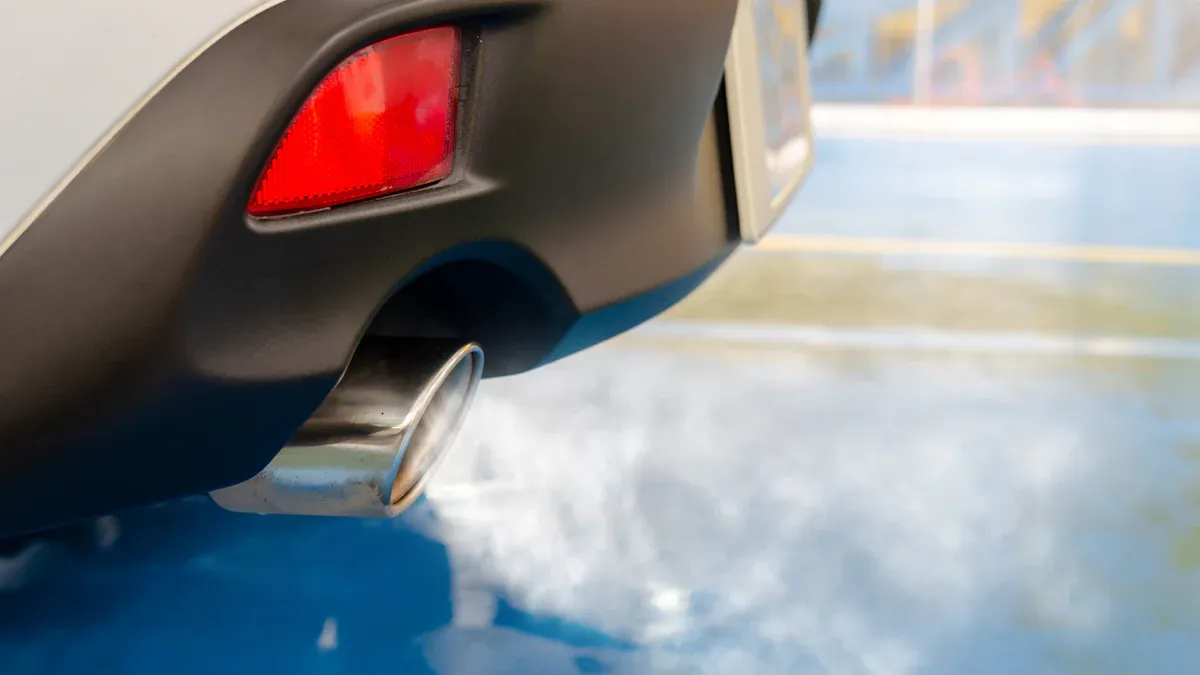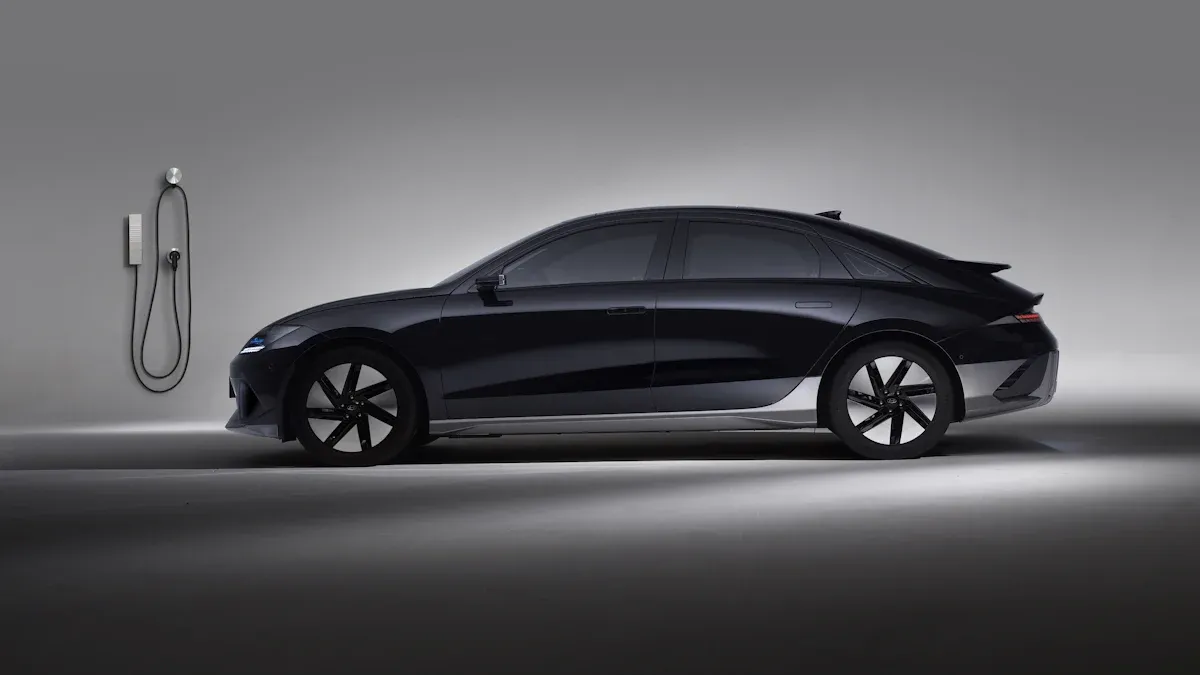Emission System Issues: How Different Car Models Stack Up
You might not know it, but your car's exhaust emission system plays a crucial role in helping the environment. It significantly reduces harmful gases like carbon monoxide (CO), hydrocarbons (HC), and nitrogen oxides (NOx). These exhaust emission systems have greatly diminished pollution levels. For example:
HC emissions have gone down by 99.7%.
NOx emissions have decreased by 99.6%.
These changes illustrate how modern cars contribute to cleaner air. However, when these exhaust emission systems fail, various problems can arise. Older cars, particularly those over 10 years old, tend to pollute much more. A 25-year-old car produces five times more hydrocarbons than a newer model. This not only harms air quality but also affects your car's performance and can lead to violations of environmental regulations. Understanding how these exhaust emission systems work empowers you to make better choices for the planet.
Key Takeaways
Your car's emission system helps clean the air by reducing pollution.
Older cars, especially over 10 years old, pollute much more.
Taking care of your emission system avoids big repair costs.
Driving calmly and not speeding can lower your car's pollution.
Picking hybrid or electric cars cuts down harmful emissions a lot.
Checking a car's emission system before buying helps the environment.
Good-quality fuel keeps your emission system working well and boosts performance.
Learn about recalls or problems with your car's emission system to stay safe.
Understanding Exhaust Emission Systems

How Exhaust Emission Systems Work
Key Components and Their Functions
Your car's exhaust emission system has several important parts. Each part helps reduce harmful gases:
Exhaust Manifold: Collects gases from the engine and sends them to the pipe.
Exhaust Pipe: Connects the manifold to the catalytic converter for smooth gas flow.
Catalytic Converter: Changes harmful gases like CO, HC, and NOx into safer ones.
Muffler and Resonator: Lowers engine noise and controls gas movement.
Some systems also use advanced tools like Diesel Particulate Filters (DPF) and Selective Catalytic Reduction (SCR). DPF removes almost all particles, while SCR lowers NOx using a chemical process.
Component | Function |
|---|---|
Catalytic Converter | Turns CO, HC, and NOx into less harmful gases. |
Diesel Particulate Filter (DPF) | Cuts particle emissions by up to 100% but needs cleaning to work well. |
Selective Catalytic Reduction (SCR) | Lowers NOx by adding diesel exhaust fluid before it reaches the catalyst. |
Role in Reducing Greenhouse Gas Emissions
The exhaust emission system helps cut greenhouse gases. Catalytic converters use special metals to change harmful gases into safer ones. This process reduces CO, HC, and NOx when working properly. New tools like the Universal Engine Exhaust Gas Simulator help test emissions on different engines. This ensures systems meet strict environmental rules.
Common Problems in Exhaust Emission Systems
Catalytic Converter Failures
Catalytic converters can fail due to overheating or contamination. When this happens, your car pollutes more and may fail tests. Regular care can stop these problems and keep the system working well.
Oxygen Sensor Malfunctions
Oxygen sensors check the air-fuel mix in the engine. If they break, your car uses more fuel and pollutes more. Replacing bad sensors quickly can improve performance and lower emissions.
Exhaust Leaks and Their Consequences
Leaks can happen in the manifold, pipe, or muffler. These leaks make the car louder and let harmful gases escape. Fixing leaks fast keeps the system working and protects the air.
Importance of Emission Systems
Environmental and Health Impacts
Cars cause 40% of air pollution in the U.S., leading to many deaths yearly. Globally, over 250,000 people die from pollution. By cutting gases like HC, NOx, and CO, exhaust emission systems help clean the air and protect health.
Regulatory Compliance and Penalties
If you don’t maintain your system, you could face fines. Many states require cars to pass emissions tests to stay legal. Keeping the system in good shape avoids penalties and ensures your car meets the rules.
Comparative Analysis of Vehicle Emission Models
American Brands
Ford: Catalytic Converter Problems
Ford trucks, like the F-Series, often have catalytic converter troubles. These parts lower harmful gases but are easy targets for theft. In 2022, over 153,000 catalytic converters were stolen in the U.S. The Ford F-Series was the most stolen due to its height and popularity. Without a catalytic converter, cars pollute more and fail tests. Checking your car often and parking safely can help prevent this.
Chevrolet: Oxygen Sensor Problems
Chevrolet cars sometimes have issues with oxygen sensors. These sensors balance air and fuel for better engine performance. If they break, cars use more gas and pollute more. The Chevrolet Silverado is known for this problem. Fixing bad sensors quickly helps your car run better and stay legal.
European Brands
Volkswagen: Diesel Emission Scandal
Volkswagen faced trouble for cheating on diesel emissions tests. They used software to hide how much NOx their cars released. This hurt their reputation and led to stricter rules for all carmakers. Since then, Volkswagen has focused on electric cars to fix its image and cut pollution.
BMW: Expensive System Repairs
BMW cars have advanced systems like SCR to cut NOx gases. These systems work well but cost a lot to fix. For example, replacing a diesel particulate filter (DPF) can be pricey. Still, these systems help BMW meet strict rules, making them a good choice for eco-friendly drivers.
Asian Brands
Toyota: Few Emission Problems
Toyota cars are known for having reliable emission systems. Their hybrid models, like the Prius, rarely have issues. Toyota cars do well in emissions tests because of smart designs and technology. This makes them a great pick for people wanting low-maintenance, green cars.
Hyundai: Exhaust Leak Issues
Hyundai cars sometimes have exhaust leaks in the manifold or pipe. These leaks let harmful gases escape before being cleaned. Fixing leaks quickly keeps the car running well and lowers pollution. Hyundai is also adding more hybrid and electric cars to reduce emissions.
Note: When comparing car emissions, look at full lifecycle impacts. This includes fuel use, electricity production, and total pollution. These factors show a car's true environmental effect.
Manufacturer | Compliance Status | |
|---|---|---|
Tesla | Below standard | Compliant |
BMW | Below standard | Compliant |
Kia | Exceeded standard | Deficit |
VW | Exceeded standard | Deficit |
Mazda | Exceeded standard | Deficit |
Other 12 manufacturers | Exceeded standard | Compliant |
Knowing how different brands handle emissions helps you choose wisely. Good systems cut pollution, save money, and avoid fines.
Data Insights on Vehicle Emission Models
Emission Recall Rates by Brand
Emission recalls help show how brands fix system problems. Recalls happen when a car can't meet environmental rules. Some brands have more recalls due to design or factory mistakes.
The Recalls Data from the National Highway Traffic Safety Administration (NHTSA) shares recall details. You can sort this data by brand and see trends over time. For example, Volkswagen and Fiat Chrysler had many recalls for emission issues. Meanwhile, Toyota and Honda have fewer recalls, showing their focus on making reliable cars.
Dataset Name | Description |
|---|---|
Recalls Data | Lists NHTSA recall campaigns, sortable by manufacturer. |
EPA Automotive Trends Report | Shares emissions data by brand but lacks recall details. |
Recalls show both problems and how brands handle them. A high recall rate may mean repeated issues. A low rate could mean better quality checks. When picking a car, check recall history to avoid repairs and stay within emission rules.
Customer Feedback on Emission System Reliability
Customer reviews help reveal how emission systems work daily. Even with testing, real performance depends on driving and upkeep. Drivers often report catalytic converter or oxygen sensor problems. These issues raise emissions and waste fuel.
Studies show interesting facts about emissions and car use:
Bigger cars use more gas and release more CO2, especially uphill.
Smooth driving lowers harmful gases compared to fast starts and stops.
Advanced tools like Selective Catalytic Reduction (SCR) work well but need care.
Toyota and Honda often get praise for reliable emission systems. Some European brands, though advanced, get complaints about high repair costs. By reading reviews, you can pick cars that balance performance and eco-friendliness.
Tip: Choose cars with strong emission system records. This helps the planet and saves repair money over time.
Factors That Affect Emission System Performance
Fuel Type and Quality
Gasoline vs. Diesel Systems
The fuel your car uses affects emissions. Gasoline engines make less NOx than diesel ones. Diesel engines, however, use less fuel and emit less CO2. Diesel cars often have tools like DPF and SCR to cut pollution. Gasoline cars use three-way catalytic converters to manage emissions. Choosing between them depends on whether you want better fuel savings or fewer emissions.
Effects of Bad Fuel on Emission Systems
Low-quality fuel can damage your car's emission system. Dirty fuel clogs filters, harms sensors, and weakens catalytic converters. This raises emissions and hurts engine performance. Studies show that clean fuels, like e-gasoline, can cut CO2 emissions to almost zero. Using these fuels with advanced tools, like pre-heated catalysts, improves performance. Always pick good fuel to protect your car and the planet.
Aspect | Details |
|---|---|
Title | Advanced Emission Controls and E-fuels for Cleaner Cars |
Key Findings | Renewable fuels cut pollution as much as regular E10 fuel. |
Conclusion | E-gasoline and advanced tools can nearly erase CO2 emissions. |
New Technologies
Sensors and Software in Emission Control
Modern cars use sensors and software to lower emissions. Oxygen sensors check the air-fuel mix for better combustion. Software adjusts the engine to reduce pollution and save fuel. Keeping your car's software updated helps its emission system work well.
Hybrid and Electric Vehicle Systems
Hybrid and electric cars help reduce emissions a lot. Hybrids use both gas engines and electric motors to save fuel. Electric cars (EVs) have no tailpipe emissions at all. Better batteries and government support make EVs more popular. Choosing hybrids or EVs helps keep the air cleaner.
Maintenance and Driving Habits
Regular Checks for Best Performance
Checking your car often keeps its emission system working well. Inspections find problems like clogged filters or broken sensors early. Fixing these issues helps your car last longer and meet emission rules. Get your car checked at least once a year.
How Driving Affects Emissions
The way you drive changes how much your car pollutes. Fast starts and hard braking use more fuel and raise emissions. Driving smoothly is better for your engine and the environment. Eco-friendly driving helps your car and reduces pollution.
Sustainability and Future Trends in Emission Systems

Innovations in Emission Control
Development of Zero-Emission Vehicles
Zero-emission vehicles (ZEVs) are a big step for cleaner air. These cars, like electric ones, don’t release harmful gases. Governments are encouraging ZEVs with rewards and stricter rules. By 2030, many countries plan to stop selling gas-powered cars. This change helps fight climate change and improves air quality.
New technologies, like ECTO-Lab, help improve ZEVs. This lab tests emission systems under real conditions. Tools like pre-heated catalysts also cut pollution during cold starts. These advancements make ZEVs more dependable and eco-friendly.
Renewable Fuels and Their Role
Renewable fuels, like biofuels and e-gasoline, are greener options. They come from natural sources and release fewer harmful gases. Studies show e-gasoline can nearly erase CO2 emissions with advanced tools. These fuels are useful where electric car charging is limited.
Direct Air Capture (DAC) technology boosts renewable fuel potential. By 2035, DAC could remove 50 million tonnes of CO2 yearly. Combining renewable fuels with new tech ensures cleaner transportation for the future.
Brand Strategies for Sustainability
Transition to Electric and Hybrid Models
Car brands are switching to electric and hybrid cars to stay green. In 2023, the electric car market grew fast, with $275 billion invested. Over 20 big carmakers aim to sell mostly electric cars by 2030. If successful, electric cars could make up 58% of sales.
Brands use different plans to meet these goals. Some focus on hybrids, while others make fully electric cars. This gives buyers more choices based on their needs and budgets.
Investment in Cleaner Technologies
Car companies are spending a lot on cleaner technologies. This includes making cars and improving their supply chains. For example:
$195 billion was invested in electric car batteries, with $190 billion already used.
Brands are adding tools like particulate filters to cut pollution.
These actions match global climate goals and show leadership in sustainability. By focusing on clean tech, brands help the planet long-term.
Consumer Role in Sustainable Practices
Choosing Vehicles with Reliable Emission Systems
Your car choice matters for the environment. Picking cars with good emission systems lowers pollution. Electric and hybrid cars are great options with fewer emissions and better fuel use. Researching a car’s emission system before buying helps you choose wisely.
Maintaining Emission Systems for Longevity
Taking care of your car’s emission system is key to sustainability. Regular checks find problems like clogged filters early. Fixing these issues keeps your car efficient and cuts pollution. Driving smoothly, like avoiding quick starts, also helps. These habits make your car last longer and reduce its environmental harm.
Tip: Get your car’s emission system checked yearly to stay eco-friendly and follow rules.
Problems with emission systems differ between car brands and models. For example, American brands like Ford often face stolen catalytic converters. European brands, such as BMW, have expensive repairs for advanced systems. Asian brands like Toyota are known for fewer emission issues, making them dependable. Older cars, especially over 10 years old, cause most air pollution. This shows why modern systems are so important.
Emission Type | Reduction Rate (%) | Year Range |
|---|---|---|
CO | 1957-2020 | |
HC | 99.7 | 1957-2020 |
NOx | 99.6 | 1957-2020 |
Picking eco-friendly cars, like hybrids or EVs, lowers harmful gases. Big car companies are creating more electric cars, and better batteries make EVs easier to buy. Regular care, like fixing leaks and checking oxygen sensors, keeps cars running well and meeting rules.
Tip: Drive smoothly and get yearly checks to help your car last longer and pollute less. Small actions can lead to a cleaner planet.
FAQ
What are vehicle emissions, and why do they matter?
Vehicle emissions are gases that come from your car's exhaust. These gases, like carbon dioxide and nitrogen oxides, harm the air. They cause pollution and make climate change worse. Cutting emissions helps clean the air and protect the planet.
How can you reduce your car’s carbon footprint?
You can lower your car’s carbon footprint by driving less often. Keeping your car in good shape and using cleaner fuels also helps. Switching to hybrid or electric cars reduces emissions a lot. These actions show care for the environment and fight climate change.
Why do automakers focus on carbon-neutral goals?
Automakers aim for carbon-neutral goals to help the environment. They also need to follow stricter rules about pollution. This change lowers their impact on the planet and attracts eco-friendly buyers.
What is the role of catalytic converters in emissions control?
Catalytic converters change harmful gases into safer ones. They help cut emissions like carbon monoxide and nitrogen oxides. Taking care of them ensures they work well and meet eco-friendly standards.
How do driving habits affect emissions?
Driving aggressively, like speeding or braking hard, raises emissions. Smooth driving saves fuel and lowers pollution. Driving carefully helps the planet and makes your car last longer.
Are electric vehicles truly carbon-neutral?
Electric cars don’t release harmful gases while driving. But their impact depends on how electricity is made. Using renewable energy makes them much better for the environment. Choosing EVs shows you care about reducing pollution.
What are automakers doing to improve their carbon performance?
Automakers are creating cleaner technologies and making hybrid and electric cars. These steps help them lower pollution and meet climate goals. Many brands also plan to become carbon-neutral to protect the planet.
Why is fuel quality important for emissions systems?
Bad fuel can harm your car’s emissions system and raise pollution. Clean fuel keeps the system working well and cuts harmful gases. Using good fuel helps the environment and keeps your car legal.
